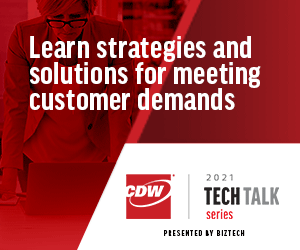The way businesses work has changed significantly in the past 14 months, and most organizations have been forced to make major adjustments to accommodate those changes. As businesses contemplate the need to rethink their infrastructure, it’s important to keep business outcomes at the forefront of the planning process.
Brett Schmidt, vice president of corporate sales at CDW, said a lot of people are looking at how to modernize their infrastructure, and the biggest challenge they run into is knowing where to begin.
“There's a challenge, and a lot of that is because the goals that they're setting around modernization, either they're not properly defined or, what we're finding in many situations, they don't appropriately align with the business's objectives,” Schmidt said.
He said that some of the most common modernization goals he’s seen include trying to align efficiencies a company might be looking at, asking themselves, “How can we reduce costs? What are things that we can do to mitigate risk, or what are the things that we can do to improve our development capacity so when the time comes and there is the demand for us to change rapidly, our business is able to quickly evolve as well?”
WATCH THE WEBCAST: Unlock the exclusive Insider video to learn more about building an infrastructure to meet your organization's needs.
People Are the First Step Toward Modernization
Schmidt identified three essential components when companies talk about modernizing their infrastructure: people, process and technology.
He noted the importance of involving the right stakeholders from the very beginning, saying, “It’s important to make sure that you are getting the appropriate business units involved, to get their feedback and listen to what they’re telling you, to make sure that you’re giving them the best overall solution.”
When an organization is in the beginning stages of developing a strategy, Schmidt said, “you’ve got to have an honest assessment. The individuals that are putting the plans together, you’ve got to understand your existing capabilities. And to do that again, you've got to have conversations with the stakeholders and talk to the various groups.”
“You’ve got to look at the different areas, not just the business units that will be impacted, but also incorporate in your IT operations, and any aspect of software development, DevOps, anything in those particular areas to make sure they're working together. It's important, as you're talking to these groups, that they understand what the other groups are looking to achieve so they can share their concerns and hopefully be able to help you miss some pitfalls that you might run into.”
When Planning to Modernize, Incorporate Business Units
The pandemic forced modernization decisions more quickly than most organizations were accustomed to making them. While some of those decisions panned out successfully, others didn’t. Schmidt offered tips on some common mistakes that could be easily avoided.
“First thing I would highlight here is you’ve got to be careful of silos,” he said. “If you're not careful and you don't look at it from a holistic standpoint, and especially incorporate in where your company is looking to go and aligning to those objectives, you could have a challenge. And then what ends up happening is you end up with inefficiencies, and ultimately your plan that you put in place is going to stall or, worst case, fail.”
Schmidt also highlighted the importance of including the appropriate business units. Different projects will require the participation of various units, he said, "but at the same time, you really do have to make sure you're incorporating your IT operations and any software development aspect of your organization.”
Register below for an upcoming CDW Tech Talk, held Tuesdays at 1 p.m., to hear from IT experts live.
The accelerated rate of decision-making brought on by the pandemic was the perfect example of why this kind of buy-in is necessary. “What we’re finding is some companies are looking to go to that next level, but if their culture isn't set up in a way where they're willing to embrace that increased pace of change, it's going to be a challenge,” he said.
“And in those scenarios, we've had conversations to let people know that it's a bigger issue than just this project. They may have to work with their executive team or others to understand what it would take to make that change, and then get that support from above” because without that sort of commitment in place, organizations will face greater difficulty in making their plans become a reality, he explained.
Strategic Partnerships Can Make Modernization More Successful
Schmidt spoke about the advantages CDW could offer in assisting customers who might be considering a modernization effort. “We have many long-standing relationships in place, so we are able to get in early on and help people early in the assessment and design phases of their particular projects. We have many world-class engineers that are on staff that have expertise and experience in different areas. These individuals have seen a lot, and they can give a lot of feedback that will help to evaluate different solutions.”
Corey Carrico, senior field marketing manager at CDW, joined the conversation to share the story of a global medical device manufacturer that experienced a surge in demand for their product throughout the pandemic. Due to that accelerated growth, their infrastructure management couldn’t keep up.
Carrico said the company was “trying to replicate that custom three-tier data center for multiple locations, and it was just becoming too taxing. You know, the current environment had multiple vendors, support was decentralized, and in many cases when you expand that globally, it just introduces some inefficiencies, especially around issue resolution.”
In evaluating the company’s situation, Carrico said CDW “initially took the approach of, as rapidly as possible, scaling that initial data center infrastructure. But it quickly became apparent that we needed something more agile. And so, we pulled in and did a hyper-converged infrastructure workshop with the customer, which allowed us to better understand the requirements and match them up with the various platforms and services that are available to the customer.”
Should Edge Computing Be a Part of Your Plan?
Mike Peck, principal system engineer at Dell Technologies, talked about the opportunities businesses now have to re-evaluate their infrastructure.
“This gives technologists a moment to take a step back, look at how their current data center and technology investments are set up, and really put that technologist’s architect hat on and align what the vision of the business is, making sure that they have created an overall blueprint in topology that is going to leverage the technologies that are going to enable that, whether that’s going to be hybrid cloud, multicloud or edge-based devices.”
In discussing edge computing, Peck said he thinks it’s only beginning. “If we take a look at some of the stats, we were seeing the vast majority of organizations are making their data in the core data center, or their on-prem data center. If you fast forward two years, most analysts believe that about 75 percent of data being created for organizations is actually going to take place at the edge. And I think we’re really in an edge-based revolution at this point, because it kind of is the Wild West. There’s a lot of innovative and incredible ways that we’re seeing customers and partners leverage edge technology, and we’re really at the beginning of that innovation curve.”
Edge computing is being used across multiple industries, from retail to engineering and agriculture, Peck said. “And I truly think that over the next two years, we’re going to see just a tremendous amount of investment, innovation and technologies really adapt to leveraging edge-based computing.”
Follow BizTech’s full coverage of the CDW Tech Talk series here. Insiders can register for the event series here.













